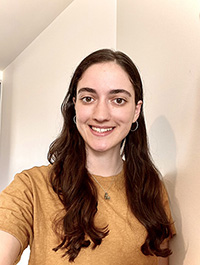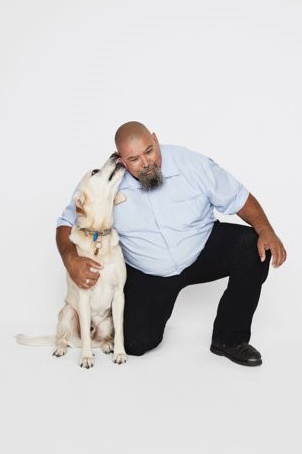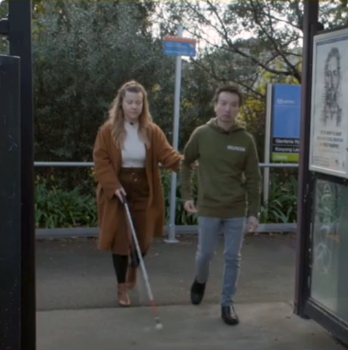Written by Elana Berton
User Experience Consultant at
Digital Access, Vision Australia

Listen to Elana talking about this tips on the Innovate for Impact podcast:
When I started working in the Digital Access team at Vision Australia I had run many user interviews and focus groups, but never with a single person who was blind or had low vision.
I was extremely nervous for my first session, and thoughts were rattling inside my head like, “what if I say something stupid? I don’t want to offend anyone” and “I can’t make any dumb assumptions”. But in the end, other than rushing through the whole thing, I really enjoyed it!
As a User Experience Researcher, the opportunity to get a completely different perspective on things and help make a real impact on someone’s life was so motivating.
I want to give anyone reading this the confidence to have a go at making their focus groups more inclusive. So here are 5 learnings for you to add to your tool box:
1. Choose the right location
a) Choose a location that is easy to access
- Make sure the location is accessible to as many transport methods as possible, e.g. car, train or bus.
- Provide detailed instructions on how to access the location, where to park or how far the nearest public transport is.
- Provide contact details instructing the participant to call when they arrive and let them know you will meet them.
- Always reimburse participants for their interview time and transport costs.
b) Make sure the location you choose has lighting that you can easily adjust
- For example, overhead lights that can be dimmed or blinds that can be closed to reduce glare.
- This is because some people with low vision can be sensitive to bright lighting. When people arrive in the room, it is good to ask them, "how’s the lighting in the room for you?” You could even ask this by email before the session, saying, “your comfort during the session is important to us, please let us know if you have any lighting preferences, e.g. reduced glare/low lighting or bright lighting.
- It is common for people who are blind or have low vision to have different preferences when it comes to lighting. The best way to cater for a group is to find a good balance between the preferences on the day.
c) Make sure there is lots of space around the table
- Clear any obstacles and trip hazards in the room.
- Arrange the furniture, so there is enough space between the chairs. This will ensure everyone can comfortably fit themselves and their dog guide (if they have one).
- Ensure there is a clear and simple pathway from the door to the table and chairs; this will make it easier to guide participants to their seats.

2. Asking people to put their hands up is okay
- It is okay to ask people who are blind to put up their hands so that the sighted facilitator can call upon people to guide the conversation.
- If you are calling on people during the session, make sure to use their names rather than just relying on looking at the person.

3. Vision is a spectrum, so your recruitment and interview guide should reflect that
a) It is important to get the right number of participants and user groups
- Just like any qualitative research, ensure you have a minimum of 3 people from each user group to help cater for the spectrum of vision (e.g. 3x people who are blind and 3x people with low vision.)
- You should never include just one person who is blind or has low vision in a focus group because the findings become very subjective to that person and their preferences.
- It is good to have two separate focus groups, one for people who identify as legally blind and another for people who identify as living with low vision. This is so you can deep dive into different prompts that are discussed in the next paragraph.
b) Your questions need to cater for that spectrum
- Example prompts for people who are low vision include; “Are you able to confidently read this information?”, “is the text size large enough?” “How is the colour contrast for you on this icon and text?”
- Example prompts for people who are blind include; “is there enough tactile definition on this button?” “would you be able to confidently tell the difference between [x product] and [y product]?” “Do you like the audio options that are available to you?” “How are the volume levels for you?”
- Even though you might have one focus group for people who are blind and another for people with low vision, it is important to have prompts for both user groups that are easy to access at any time in your interview guide/s.
- This is because people who are legally blind can often have some partial sight and, therefore, might comment on things like text size and colour contrast.
- This is also true for people who with low vision because they might rely on tactile features and audio options rather than just relying on their sight all the time, which can be tiring.
- If someone cannot read or see something well enough, it is important to ask them how they might prefer the information to be displayed or made accessible to them.
c) Consider the language you use to transition between tasks during the session.
- It is okay to say words like ‘look,’ e.g. “please have a look at ‘x product’ and let me know...”
- If you need to hand products to participants, say, “I am putting ‘x product’ in front of you on the table now”. Then, instead of handing it directly to them so that they can collect it in their own time.

4. Have at least one other colleague with you to guide people in and out of the room
a) Guiding people into the room who are blind or have low vision
- Remember to announce your name when meeting or starting a conversation with someone who is blind or has low vision, e.g. “Hi Malcolm, it’s Elana here (nice to meet you/ nice to see you again).”
- If you have never had experience guiding someone who is blind or has low vision, you first need to ask if they would like to be guided. If they say yes, ask them how they would prefer to be guided.
- You can watch this video demonstration about guiding as well as visit this webpage with more resources about guiding.
- It is important to have at least two people (you and a note-taker) so that when the participants arrive, one person can stay with the group while the other goes to meet and guide the other participants.
- If you have more than 5 people in the focus group, you might consider having a 3rd colleague help you.
- Be sure to introduce each person to the others in the room when they arrive, so they understand who is in the room. It is also good to do a formal introduction, going around the room individually once everyone is seated.
b) Guiding people out of the room in groups
- At the end of the session, it is important to ask everyone how they are getting home so that you can guide people in groups to the right location. E.g. 2 people might be taking taxis, 1 might be going to the train, and 2 might have a support person who is giving them a lift home.
- If you cannot remember what their guiding preference is, remember to ask them again and never assume, “would you like me to guide you to the taxi area?”, “How would you like me to guide you?”
- Remember, some people with dog guides don’t need to hold onto you, and they can follow you with their dog.
- There are a couple of ways you can guide groups of people if they need to all hold your arm:
- For two people, one person holding each of your arms can work (be careful when going through door frames).
- For more than 2 people, you should take turns to guide people out of the room and make sure you clearly communicate that, e.g. “I will guide Sam and Lilly out to the taxi rank first; Frances are you okay to wait here for a minutes before I guide you to the door closest to the train station?”
- Ask the participants if they would like you to call a taxi for them, and ask if they would like you to wait with them for the taxi. Some people might politely decline as they have a preferred taxi or ride-share service they use.
- It is important to note that people who are blind or have low vision might experience discrimination by taxi or ride-share services. This includes; deferring to you; a sighted person who is present and not speaking to the person directly, refusing to take them due to their dog guide, and driving off before even approaching them due to seeing their cane or dog.
- If they speak to you and not the participant, redirect them to speak to the participant instead, “James can tell you his address”. If they refuse to take the participant because of their dog, the participant might remind them it is illegal to refuse a customer due to their dog guide; you can also help stress this point. If you can see the number plate, try to remember it (or take a phone photo), so you can help your participant report the driver's behaviour.

5. Other general rules you can keep in your toolbox
- Other than the 4 tips above, focus groups with people who are blind or have low vision are no different to focus groups with people who are fully sighted.
- If you are unsure, always ask instead of assuming.
- Don’t talk to people who are blind or have low vision any differently than people who are fully sighted. Remember never to raise your voice or yell when talking to them, always address questions to them rather than their support person and never interact with their dog guide.
- Ask all the same general questions about how the user experience is for them, whether they have had better experiences elsewhere, hacks they might use or why something is or isn’t working for them.
- It might be a good idea to run a pilot test of your interview guide with someone who is blind or has low vision before the focus group sessions.

You might feel nervous or awkward at times, but that’s super normal and something I personally feel before every focus group or user interview!
If you have any questions about running focus groups with people who are blind and have low vision, don’t hesitate to reach out to me on LinkedIn 😊
Other inclusive design resources
- Inclusive typography webinar
- Short interviews with people with disabilities
- Screen reader demo
- Screen magnifier demo
Want help to design more inclusively?
- Learn more about Inclusive design for people with disability
- Organise a focus group or round of user research
- Understand how you can embed accessibility into your organisational processes
Email Digital Access or check out our services page for more details.










